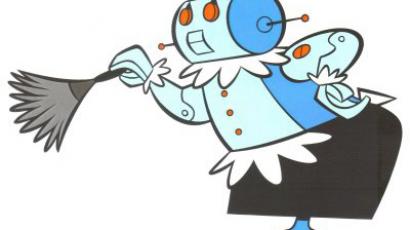Robo-goo-goo: Totbot replicates infant speech (VIDEO)
Scientists have been racking their brains for years, trying to figure out how we learn to talk. Now they have created a “child-bot” that can learn to speak like a baby.
After a few minutes conversation with human “teachers”, the robot learns to understand the most frequently-heard syllables and is able to reproduce some basic words.The study, published in the science journal PLoS One, has shed some light on how babies develop from babbling to saying their first words. Scientists at the University of Hertfordshire in England built a three-foot-tall robot, which they christened DeeChee and which can reproduce any syllable in the English language. The research used human volunteers to teach the robot simple words for colors and shapes. At the beginning of the experiment DeeChee could only understand an unbroken stream of sounds, but was programmed to break them up and store them in its memory. Later on it could replicate words like “red” or “green” in the conversation.DeeChee was also taught by the volunteers to recognize words of encouragement like “well done” and “good”. The kid-bot could transform babble into coherent words in just a couple of minutes, the researchers found.Caroline Lyon, one of the scientists behind the research, says that one of the reasons babies use nouns like “mama”, “dada” and “red” first is that they are easier to recognize than linking words like “of” and “at”, which are spoken in hundreds of different ways and can sound different to a new speaker.
The interaction between the robot and its researchers was important to the experiment. DeeChee was programmed to blink at its teachers when it needed a break and smile at them when it was ready to pay attention.Lyon said in an interview with the LA times that it was crucial for the volunteers to relate to DeeChee as a person and not a robot. “When we asked people to talk to the robot as a small child, it seemed to come quite naturally to them, but when they talk to a bit of disembodied software; you don't get the same response." She said. Scientists in Japan have gone even further. They have also created a “child-bot” called CB2. Smaller than DeeChee, it has developed some social skills, including mimicking facial expressions and has taught itself to walk. Professor Minoru Asada of Osaka University, whose team designed CB2, believes that in a few decades science will invent a robo-species that has the learning capabilities somewhere between a chimpanzee and a human. His goal is to build a “robo- child” which can speak in basic sentences, and by 2050, wants a robotic team of football players to play against a human team and win. Japanese scientists are already on the way to achieving his dream. They have designed a “fashion-bot”, which can strut down the catwalk and pout, thanks to 42 tiny motors programmed to mimic human models. Fumio Miyazaki, an engineering science professor at Osaka University believes that within a decade or so robots could be working alongside humans – if that is what society wants.But Dr. Lyon, in an interview with RT, was more skeptical. “We are not creating intelligence; we are creating a robot with certain abilities.” However, she shared Professor Miyazaki’s view that we will work alongside robots. Her team has also worked on robot “companions” to help people with disabilities around the house.













